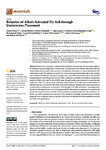Behavior of Alkali-Activated Fly Ash through Underwater Placement
| dc.contributor.author | Yahya, Z | |
| dc.contributor.author | Abdullah, MMAB | |
| dc.contributor.author | Li, Long-yuan | |
| dc.contributor.author | Burduhos Nergis, DD | |
| dc.contributor.author | Hakimi, MAAZ | |
| dc.contributor.author | Sandu, AV | |
| dc.contributor.author | Vizureanu, P | |
| dc.contributor.author | Razak, RA | |
| dc.date.accessioned | 2022-01-17T13:38:45Z | |
| dc.date.available | 2022-01-17T13:38:45Z | |
| dc.date.issued | 2021-11-14 | |
| dc.identifier.issn | 1996-1944 | |
| dc.identifier.issn | 1996-1944 | |
| dc.identifier.other | 6865 | |
| dc.identifier.uri | http://hdl.handle.net/10026.1/18564 | |
| dc.description.abstract |
<jats:p>Underwater concrete is a cohesive self-consolidated concrete used for concreting underwater structures such as bridge piers. Conventional concrete used anti-washout admixture (AWA) to form a high-viscosity underwater concrete to minimise the dispersion of concrete material into the surrounding water. The reduction of quality for conventional concrete is mainly due to the washing out of cement and fine particles upon casting in the water. This research focused on the detailed investigations into the setting time, washout effect, compressive strength, and chemical composition analysis of alkali-activated fly ash (AAFA) paste through underwater placement in seawater and freshwater. Class C fly ash as source materials, sodium silicate, and sodium hydroxide solution as alkaline activator were used for this study. Specimens produced through underwater placement in seawater showed impressive performance with strength 71.10 MPa on 28 days. According to the Standard of the Japan Society of Civil Engineers (JSCE), the strength of specimens for underwater placement must not be lower than 80% of the specimen’s strength prepared in dry conditions. As result, the AAFA specimens only showed 12.11% reduction in strength compared to the specimen prepared in dry conditions, thus proving that AAFA paste has high potential to be applied in seawater and freshwater applications.</jats:p> | |
| dc.format.extent | 6865-6865 | |
| dc.format.medium | Electronic | |
| dc.language | en | |
| dc.language.iso | en | |
| dc.publisher | MDPI AG | |
| dc.subject | alkali-activated | |
| dc.subject | class C fly ash | |
| dc.subject | fresh water | |
| dc.subject | seawater | |
| dc.subject | underwater placement | |
| dc.title | Behavior of Alkali-Activated Fly Ash through Underwater Placement | |
| dc.type | journal-article | |
| dc.type | Journal Article | |
| plymouth.author-url | https://www.ncbi.nlm.nih.gov/pubmed/34832267 | |
| plymouth.issue | 22 | |
| plymouth.volume | 14 | |
| plymouth.publication-status | Published online | |
| plymouth.journal | Materials | |
| dc.identifier.doi | 10.3390/ma14226865 | |
| plymouth.organisational-group | /Plymouth | |
| plymouth.organisational-group | /Plymouth/Faculty of Science and Engineering | |
| plymouth.organisational-group | /Plymouth/REF 2021 Researchers by UoA | |
| plymouth.organisational-group | /Plymouth/REF 2021 Researchers by UoA/UoA12 Engineering | |
| plymouth.organisational-group | /Plymouth/Research Groups | |
| plymouth.organisational-group | /Plymouth/Research Groups/Marine Institute | |
| plymouth.organisational-group | /Plymouth/Users by role | |
| plymouth.organisational-group | /Plymouth/Users by role/Academics | |
| dc.publisher.place | Switzerland | |
| dcterms.dateAccepted | 2021-11-12 | |
| dc.rights.embargodate | 2022-1-18 | |
| dc.identifier.eissn | 1996-1944 | |
| dc.rights.embargoperiod | Not known | |
| rioxxterms.versionofrecord | 10.3390/ma14226865 | |
| rioxxterms.licenseref.uri | http://www.rioxx.net/licenses/all-rights-reserved | |
| rioxxterms.licenseref.startdate | 2021-11-14 | |
| rioxxterms.type | Journal Article/Review |


